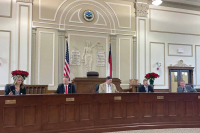Sylva aims to ban downtown workers from parking on main shopping drag
The town of Sylva plans to impose a new parking law to stop shop owners and employees from taking up customer parking on Main Street.
While most towns in the region face the same challenge — what to do about downtown workers monopolizing coveted parking spaces — only Highlands has tried to legislate a solution so far.
Highlands has an ordinance barring employees from parking on Main Street, a model Sylva now wants to emulate.
The new ordinance comes as part of a larger attempt to fix the parking pinch in downtown Sylva, which has shop owners on Mill and Main streets infuriated by the lack of available customer parking during peak business hours.
To help alleviate the problem, the town board recently decided to rent a commercial lot near the intersection of Mill and Main and designate it for free public parking.
It will provide between 30 and 40 additional parking spaces downtown, but the board felt it needed to go a step further.
Last week, the town’s attorney Eric Ridenour offered the board a first draft of the ordinance, which would bar employees of downtown businesses from on-street parking along the one-way portions of Mill and Main streets.
Ridenour told the board that Highlands’ version of the ordinance includes an exception for service-oriented businesses like real estate offices, which need to keep their vehicles close to serve customers.
Board Member Sarah Graham said she didn’t see the need to make exceptions, particularly given the town’s investment in leasing an additional lot.
“We should free up as many spaces downtown as possible,” said Graham.
Board Member Danny Allen agreed.
“The town (now) has three parking lots, and they’re all in close proximity to one end of town,” Allen said. “It’s not going to require but a hop and a skip for them.”
The board considered a provision that would reserve spots in the newly leased lot for businesses willing to pay a rental fee.
That suggestion didn’t thrill Sylva Police Chief Jeff Jamison, who said it would be difficult to enforce.
“We’re going to be policing that lot as well as Main Street. Is that what I’m hearing?” Jamison asked. “That’s going to be difficult folks.”
The board ultimately struck the idea from the draft ordinance.
Enforcement a challenge
Ridenour said the ordinance would rely heavily on the cooperation of business owners to report violations to the Sylva police, since the department doesn’t have any staff dedicated to parking enforcement.
“The way I drafted it is in the hope that our downtown business owners will work as our eyes and ears,” said Ridenour.
The town not only lacks a dedicated parking cop, but enforcement would hinge on police officers’ ability to visually recognize the vehicles of downtown workers. If a worker’s car is indeed spotted in a parking space that’s off-limits to them, another challenge is determining whether that employee is on their shift — or happens to be shopping downtown on their day off. The board plans to hold a public hearing on the ordinance at its second meeting in July.
Sylva is not alone in confronting the issue of employees and business owners parking in spots that were meant for their customers. Waynesville’s Town Manager Lee Galloway said the problem is ubiquitous.
“I’ve worked in six towns, and I don’t think there’s one that didn’t have the same issue,” Galloway said.
Galloway recalled a running joke in Rockingham about a jeweler named Fox.
“Why does Mr. Fox park right in front of his business? Because he can’t get his car inside,” Galloway said.
Galloway said Waynesville has addressed the issue by adding more public parking –– in particular a large parking deck a block off Main Street –– and by enforcing three-hour parking limits on Main Street.
In addition, the Downtown Waynesville Association has taken on the responsibility of communicating with business owners about the need to keep customer parking free.
“We’ve tried to handle it amongst ourselves,” said Buffy Messer, the downtown association’s director. “I think the merchants try to communicate with their neighbors. We don’t mind if someone parks all day as long as they’re spending money.”
Bryson City has the same problem, especially during the high season, but Town Manager Larry Callicutt said thus far no one has suggested drafting an ordinance to confront it.
“I’m not sure there’s a town where that doesn’t happen,” said Callicutt. “They’ve always complained about it, but it’s not gotten to the point that anyone’s taken action on it.”
Galloway said he understands merchants’ anger over the issue.
“You have to turn those spots over to protect your merchants,” Galloway said. “I understand their frustration.”
Can’t pop the top
As part of the major renovation of the historic Jackson County Courthouse, workers from Brantley Construction were set to remove the building’s signature dome last Friday. But three separate attempts to lift it off by crane failed.
The wood inside the dome has been compromised by rot, and Brantley’s carpenters are ready to restore it. But they need to be able to reach it first.
The removal process began at 10 a.m. on Friday morning, and the crews expected to have the dome off before lunch. But the project’s manager, David Cates, stressed all along that there was no exact schedule for getting the dome down.
Interested citizens, photographers and well-wishers gathered throughout the day to watch the momentous occasion, but in the end, the old dome proved stubborn.
The removal process entailed installing a steel frame around the dome to support its weight. The frame was hooked to a crane that could lift it free from the main structure of the Courthouse.
Before that could be done, work crews had to remove the bolts that held the dome to the courthouse roof then cut it all the way free with saws.
According to the Friends of the Jackson County Main Library, the project’s manager determined a heavier crane was needed for the job, and the attempts were abandoned around 5 p.m.
The removal will be re-attempted when the new crane is in place.
Sylva woodworker goes back to the future
In our commodity-driven world, it may seem absurd to spend a year making a table. But for Sylva woodworker Brian Bartel, a year is just a fiber in the grand tapestry of tradition.
“My grandpa lived across the street from me growing up, and he taught me how to work hand tools,” Bartel said. “I was older before I realized what he’d done to me.”
Bartel recently completed work on a nine-foot long dining room table, its top a slab of three-inch thick black walnut. The project, which took more than a year to complete, was commissioned by Sylva part-time resident Sean Weaver and required milling more than 75 board feet of lumber to fine the choicest grain.
Weaver had a vision in his head of a dining room table that would serve as the focal point of his house. He didn’t want the piece to be something you could find anywhere else.
“I started asking around to a bunch of different woodworking people, and the fingers all started pointing at him as someone who could pull this off,” Weaver said.
Bartel, who moved to the mountains from Central Florida 12 years ago, has followed his own path to becoming a master craftsman.
Having gotten his start woodworking through construction and remodeling jobs, he eventually began making furniture using recovered barn wood and featuring old designs that employed hand-cut joints.
Along the way, Bartel started buying old tools whenever he found them, assembling a collection of hundred-year old planes, chisels and saws that he outfitted in a custom cabinet complete with tiny toggles to keep them in place.
Weaver’s table assignment came along just as Bartel was looking for a challenge worthy of the name.
“This table right here is so far out of the realm of what I’ve ever done,” Bartel said. “It’s really pushed me. I’m pleased with it.”
The table’s top weighs more than 400 pounds and is adorned with hand-cut bow-tie inlays of white sycamore and African wenge wood. Ten metal screws affix the top to the base, and that is the only metal in the project. Every other attachment is functional joinery.
But the story of the table is not in its final design, its fancy adornments or its glossy finish.
“When I first met this table, I met it in the wood,” Bartel said.
Bartel and Weaver spent weeks looking for wood, before they settled on a massive black walnut tree that had been cut in a local yard and chopped into logs. The wood then had to be milled into slabs and studied for quality. Then it had to be kiln dried.
“There’s no drying schedule for wood that thick,” Bartel said.
Weaver and Bartel designed it together, using the vision of the patron and the know-how of the craftsman.
“You’re letting the wood be itself, but you’re conforming it to what you want,” Bartel said.
Bartel only uses Japanese planes because they cut so precisely, and he is as familiar with the philosophy of his art as its practice. He counts George Nakashima’s The Soul of a Tree and James Krenov’s A Cabinetmaker’s Notebook as parts of his toolkit.
To Bartel, wood is a living thing and woodworking is a live tradition, as evidenced by a restoration project he undertook recently for another customer.
Bartel was able to reliably date the antique as a 17th century relief-carving panel made of Honduran mahogany and fabricated in central Europe. That means the panel came from the New World to Spain on a ship and was sold to a merchant who moved the wood to the interior of the continent. Bartel’s first job was to take off the finish to see what he had.
“When I got the wash off of it I realize I was the first guy in 400 years to see this piece in that kind of detail,” Bartel said.
For Bartel, the connection to the past is not accidental.
“It’s like I could have been making my living like this 100 years ago and very little would have changed,” Bartel said.
But a year for a table can’t ever be considered typical. Bartel nearly lost his temper after he put a finish with too much talc on, layer after thin layer. The finish obscured the shine in the wood grain and he had to take it off.
“Right now I’m at that point. I’ve got blisters on my thumbs. I’ve sanded it a dozen times. Every aspect of the thing has to be perfect and over the course of a year, and it’s like...” Bartel stopped and shook his head.
But now the table is done, a work of art, the centerpiece of Weaver’s home. Weaver said he already has plans for more of Bartel’s furniture in his home. For Bartel, the market is telling him that in the end, people will pay for the winding road he has taken to his craft.
“It seems like value is coming back,” Bartel said. “People will spend money on something that will last forever.”
And now he has a piece of work that can stand the test of time with his own sign etched into the grain of the black walnut.
“As hard as this has been, it’s something I’ll remember the rest of my life,” Bartel said. “This process is still alive.”
Exploring Sylva’s secret garden
Jay Coward is no stranger to Pinnacle Park.
When the work day ends, Coward often trades in his attorney’s suit and tie for hiking attire and escapes into the 1,000-acre wilderness at Sylva’s doorstep. An intergral player with the Pinnacle Park Foundation since the early ‘90s, Coward notices every spiderwort bloom, every bit of trash and every burgeoning erosion issue in the forest. Hiking with Coward, you begin to understand why so many longtime Sylva residents have put so much work into keeping it wild. He first visited the Fisher Creek watershed on a church retreat as a young boy.
“This is one of the most beautiful places in the world, I think,” Coward said. “It’s got two of the most beautiful peaks in the Southern Appalachians –– the Pinnacle and Black Rock.”
With the preserve safe from development in perpetuity as a result of a 2006 conservation agreement, the question these days is how to get it ready to deal with more people as discovery of the secret enclave is inevitable.
The History
Pinnacle Park is a 1,000-acre tract, bounded by steep ridges, that drains the east and west forks of Fisher Creek. The creek was dammed up and served as the source of Sylva’s drinking water.
During a period of prolonged drought in the mid-‘80s, the watershed failed to meet the town’s needs, which were also expanding.
At one point, things got so bad that National Guard tankers were forced to deliver water to the hospital. The crisis led to the mothballing of the old watershed in 1992 and the creation of the Tuckaseigee Water & Sewer Authority, which now pulls drinking water from the river.
The same scenario played out in Bryson City, Canton and Murphy, as small watersheds were no longer able to support water demands of their growing populations during drought seasons.
Bill Gibson, the head of Region A at the Southwestern Planning Commission, was watching closely, fearing what may happen to the vast tracts now that they were no longer needed as a source for drinking water.
Gibson said he first heard the idea of preserving Sylva’s old watershed from Tom Massie, who was assistant county manager for Jackson County at the time. Massie and Sylva Mayor Brenda Oliver were behind the push to save the watershed from logging or development.
That same year, 1992, the town of Sylva passed a resolution to preserve the area for conservation, preservation, and recreation. But Coward wanted more certainty than a verbal pledge that could be reversed by the next slate of elected leaders.
“We really needed more than just a resolution,” Coward said. “Because we knew the board might not get re-elected.”
Coward worked with Gibson and others to form a broad-based board of directors for a new nonprofit, The Pinnacle Park Foundation, and they leased the watershed from the town for 25 years, ensuring a new town board couldn’t come in and overturn the policy of preservation.
But the concern persisted that future town leaders would see the old watershed as an asset to be exploited. Some people wanted to log it. Others saw it as a property ripe for development. As a town commissioner at that time, current Sylva Mayor Maurice Moody said the town needed to get more out of it than a nice view.
Those arguments came to a head in 2005, and the town contracted Peter Bates, a forestry professor at Western Carolina University, to survey the property and determine its value. Bates’ team spent the better part of the year studying the old watershed. It found that while there were a few stands of good timber, the area was so steep and inaccessible that it would cost more to log than it would yield.
“Based on that opinion from him, the whole idea of logging went away,” Coward said. “Plus by that time, we had significant enough ammunition to go to the town board and say, ‘Let’s get a conservation easement.’”
In 2006, with the assistance of the Land Trust for the Little Tennessee, Sylva entered a conservation agreement that would permanently restrict development and logging and keep it wild forever. The Clean Water Management Trust Fund gave the town $3.5 million in exchange.
“It was a sustained feeling and policy. A sustained set of ideals that transcended people and changes in the board. It never died,” Gibson said of the movement.
The Park
“The idea of having a park like this is a pretty unique thing for a little town,” Coward said.
Most towns don’t have the resources to deal with a 1,000 acres of wild green space. Pinnacle Park is a steep, rocky piece of land traversed by two old logging roads. One road travels along the west fork of Fisher Creek toward the ridgeline and Pinnacle Peak; the other follows the east fork up toward Black Rock and a rough trail that continues on to Waterrock Knob via the old foxhunter’s camp.
Both of the old roads — which are now foot trails — are gateways to tremendous tracts of public land, full of beautiful views and waterfalls, but they’re also very, very steep. Some stretches have a slope of 70 percent, poor for walking and worse for erosion control.
Ever since the Pinnacle Park Foundation was formed, it has had the challenge of maintaining and developing its trail system. The town has helped and so have civic organizations like the Rotary Club and the Boy Scouts, but much of the effort has been undertaken by Coward, who walks the land like a protective parent.
“Every long movement has to have one really pugnacious, patient guy who will do the same things over and over again,” Coward said.
On a recent trip to the park, Coward pointed out recent developments on the trail system’s lower section, which weaves in and around the old dam that anchored the watershed.
The trails in that part of the park, which Coward said are close to being considered handicap accessible recreation trails, were opened with help from the Rotary Club in 1999.
Last year, the town contributed $25,000 to the park. The money went to improve the parking area, which was severely undersized and inadequate; build footers for bridges over the creek; and create a more robust system of sediment control on the old logging road that is the principal path in the park.
As Coward crossed the creek, he spotted a Busch Lite box at the edge of a deep pool. He scrambled down the bank, retrieved it and told a story about the pool.
“One of the residents nearby came to me and said, ‘I saw naked people swimming around in there,’” Coward said. “And I said, ‘What’s wrong with that?’”
The man scratched his head.
Pinnacle Park is more open and accessible than it’s ever been before, but it’s still underdeveloped. Erosion and kudzu are ever-present concerns. The lower trail system needs four bridges before it provides real accessibility for people who won’t be able to enjoy the upper reaches of the park.
Meanwhile trail signage is limited, the park lacks an official map, and its main thoroughfares are too steep for most people.
But for Coward, the hard part of the battle has been won already.
“I think the philosophical achievement is just to set the example of what you can do. You can preserve a wilderness area. We did,” he said.
The Future
Too many people have put too much work into Pinnacle Park for it to remain inhospitable to the public.
At the same time, the wildness of the place, its lack of strict regulations, and even its very steepness are part of what make it great.
If you live in Sylva, you can drive to the park and be out of your car in 15 minutes. In another 30 minutes you can be sitting under a waterfall. And, unlike in the Great Smoky Mountain National Park, you can bring your dog along, too.
Recognizing the park’s unique place in the public land structure in Jackson County, Emily Elders, Jackson County Greenways director, worked to get the county in line to offer some of its resources to the effort to develop the park.
“A lot of local people grew up fishing, hunting and hiking it, and it’s an opportunity to carry over that respect for the place to preserve a natural site in its wild state,” Elders said.
Elders has access to the N.C. DENR’s trail-building teams and has worked with area director Tim Johnson to map out a strategy for making the trails at Pinnacle more friendly to the environment and hikers both.
Coward also has ideas about where trails should be, and the town recently formalized a camping policy that will go into effect after three designated campsites are completed. Those are big steps in and of themselves.
In short, while Pinnacle Park has a long list of needs, it’s also a few baby steps away from being in pretty good shape to handle a moderate amount of locally driven traffic, particularly in its lower reaches.
As Coward got back into his truck in the new, roomy gravel parking lot, a truck pulled up and two young backpackers unloaded.
“We came up to do some paddling and stopped at Black Rock Outfitters and asked where we could camp,” said Derek Bradley 22, of Marietta. “And they said, ‘There’s the Pinnacle.’”
Coward whipped out a topographic map of the watershed he had in his truck. There are no maps sold or distributed locally. He showed Bradley and his friend Brendan Meyers what their options were, and the two spry young men headed up the trail headed for the one and a half hour walk to the Pinnacle.
“The Pinnacle, because it juts right out into the community is sort of an intimate place,” Coward said. “Black Rock is windswept. It really ought to be called Pinnacle.”
And just like that, Coward touched on the secret of the park. It’s an unlabeled green space with close ties to the people and the place.
The park still has plenty of secrets to unfold, like the falls on the West Fork, but for now, its mystery remains a part of its development.
“If it’s just sort of under the radar, it keeps the impact down a little bit,” Coward said, smiling slyly.
How to get there?
The Pinnacle Park trailhead lies at the end of Fisher Creek Road. To get there from Sylva, take Skyland Drive all the way out of town and cross under the Great Smoky Mountain Expressway. Make your second left onto Fisher Creek Road and continue to the end.
Downtown Sylva to get more free parking
Years of complaining by Sylva merchants that there isn’t enough parking downtown has spurred the Sylva town board to lease a private parking lot near the intersection of Mill and Main Streets.
The board voted 4 to 1 to lease the Sammy Cogdill parking lot for $400 per month in order to alleviate a perceived parking crunch and to address concerns about the safety of oversized vehicles parking in diagonal spots.
The ongoing debate over parking in downtown Sylva resurfaced in May when Western Carolina University student Thaddeus Huff published the findings of a downtown parking study he conducted as part of his graduate research. His conclusion contested the idea that there was a parking shortage in Sylva. Huff’s study found there were plenty of spaces in the greater downtown area — people just weren’t willing to walk more than a block to their destinations.
Huff’s study did identify the south end of Main Street as the area most in need of parking, and he suggested encouraging people to park in other parts of town as a solution.
Many local merchants, however, believed that Huff’s study — which was conducted in March — didn’t take into account congestion during the most heavily trafficked time of year or during festival weekends. They cited anecdotal evidence that customers routinely struggle to find parking at key times of day.
The town board’s vote to rent the Cogdill lot for a year should put the discussion to rest.
“It’s an opportunity for us to see if it makes an impact,” said Town Commissioner Chris Matheson.
Matheson said her vote was based as much on safety concerns as on the lack of available parking spaces downtown. Matheson said oversized vehicles parking in diagonal spots make Main Street dangerous.
“If you’re on the right side of one of those vehicles, you’re backing into an abyss,” Matheson said.
Board Member Ray Lewis was the only dissenting vote. Lewis objected to the notion of the town committing more money to downtown Sylva and suggested the money to lease the Cogdill lot should come out of the town’s annual $12,000 allocation to the Downtown Sylva Association.
Lewis’s stance on the subject may foreshadow a point of contention in the upcoming budget discussions. Town financial support of DSA has been controversial each of the past four years during budget time.
Mayor Maurice Moody said parking and DSA funding were separate issues, however.
“I think those are two separate issues and the majority of the board wants to leave DSA funding at $12,000 where its has been for the past few years,” Moody said.
The board also discussed other ways to alleviate the parking shortage in Sylva, including the option of adopting a parking ordinance similar to one in the town of Highlands that prohibits merchants and their employees from parking on the Main Street during business hours. Another alternative would see the town rent some of the spaces in the Cogdill lot to businesses that wanted to reserve spaces for their employees.
All of those discussions were informal. Moody confirmed that the Cogdill lot would be open to the public July 1 and that the bulk of the spots would be used for additional free parking.
Civil suit targeting Jackson sheriff fails
“The only reasonable verdict here is for Sheriff Ashe,” Patrick Flanagan told the jury. “He did not commit any wrongdoing here.”
The eight-person jury in the Bryson City federal courtroom agreed, taking slightly less than an hour to clear Jackson County Sheriff Jimmy Ashe on five complaints that alleged he used his position and influence to interfere with the business operations and free speech of David Finn, owner of Blue Ridge Public Safety. Blue Ridge Public Safety is a private security force hired by upscale developments in the greater Cashiers area to patrol their communities.
The case pitted two of Jackson County’s leading law enforcement officers against one another in the federal district courtroom of U.S. District Judge Martin Reidinger.
Finn’s lawyer, Frank Contrivo Jr., spent three days calling witnesses, reviewing subpoenaed phone records, and otherwise building the case against Sheriff Ashe.
Ashe’s lawyer, Patrick Flanagan took only a few hours to offer a defense.
His message was simple: The only evidence that Ashe had interfered with Finn’s contracts was circumstantial, and Ashe’s own testimony that he had not used his office to put Finn under duress was credible.
Finn first sued Ashe in 2007, accusing the sheriff of using his position to scuttle the sale of Blue Ridge Public Safety to an Asheville buyer named John Hale.
The complaints alleged that Ashe, working in concert with a lawyer for an influential group of Cashiers-area residents, inappropriately shared information that led to a slew of investigations into Finn’s business, which holds security and patrol contracts worth more than $1 million.
The day before Flanagan called his defense witnesses, Contrivo withdrew the leading claim driving the case thus far –– that Ashe had actively participated in ruining the sale of Blue Ridge Public Safety to John Hale for $1.5 million.
With that claim off the table, the case came down to whether Ashe interfered with six existing Blue Ridge Public Safety contracts and on whether he infringed on Finn’s First Amendment right to free speech.
According to Finn, Ashe was motivated to disrupt the business of Blue Ridge Public Safety because of a disagreement between the two men over proposed legislation that would have given company police broader powers, including jurisdiction on U.S. highways adjacent to the communities they patrol.
An important component of Contrivo’s case for Finn was the extent to which Ashe communicated with Cary-based Lawyer Mark Seifert and his clients. Seifert created and represented two groups: the Committee of Sapphire Homeowners and the Sapphire Association of Concerned Citizens Committee.
Seifert testified that he was hired by Cashiers property owners in 2006 to investigate Finn and that his goal was to put Blue Ridge Public Safety out of business.
Contrivo alleged that Ashe and Seifert “were singing a duet” as they worked in concert to manufacture claims against Blue Ridge Public Safety that hurt the business and ruined contracts. He showed through phone records that Ashe and Finn had had extensive contact with one another –– nearly 150 calls amounting to 30 hours of conversations.
“What we’ve seen in the past three days is a snapshot of the nightmare experienced by Mr. Finn’s business,” Contrivo told the jury in his closing argument.
Flanagan, who served as a captain in the U.S. Army JAG Corps, presented an argument that was repetitive, process oriented and clinical. He focused on the fact that not one witness testified to Ashe’s direct participation with Seifert or even to the fact that Ashe had spoken ill of Blue Ridge Public Safety.
“What we didn’t hear at all –– there was no evidence, no testimony –– was that the sheriff has ever made a derogatory comment about Mr. Finn or his company,” Flanagan said.
In contrast, Contrivo at times raised his voice to cajole the jury and at other times spoke in a barely audible whisper to contribute to the gravity of the moment. He tried to paint a picture of Ashe as an expert at behind the scenes deal-making who managed to get away with a crime by staying at arm’s length from it.
“We hear about a man who was turf conscious, jealous of his power, and jealous of what he perceived as a threat to his power,” Contrivo said, pointing at Ashe.
Contrivo asked the jury for $200,000 worth of damages to cover Finn’s lost contracts and legal fees. The jury wasn’t convinced. They cleared Ashe on each charge and entered zeroes in the spaces on the verdict sheet that asked for award amounts.
After the trial, Ashe said the verdict upheld his faith in the system.
“This has been a long process that needlessly burdened the taxpayers of our community,” Ashe said. “The quick verdict of the jury attests to what we have asserted from the beginning of the matter.”
Ashe also indirectly expressed his dismay that he had spent so much time over the past two years embroiled in the civil suit.
“There is no business more important than the people’s business, and I am proud of the confidence that the good people of Western North Carolina have shown in me and our deputies,” Ashe said. “I look forward to many more years of public service, and it’s time to get back on task.”
Neither Finn nor Contrivo responded to requests from comment on the case after the trial, so it is not clear whether they plan to appeal the verdict.
Flanagan said a potential appeal could take two forms. In the first scenario, Contrivo could make a motion to Judge Reidinger to set aside the jury’s verdict in his final judgment, which will be entered in the next few weeks.
A second approach would be for Contrivo to file an appeal with the Fourth Circuit Court of Appeals in Richmond, Va. within 30 days of the final judgment being entered.
Jackson library campaign marks success, new goals
On May 25 the Friends of the Jackson County Main Library marked the completion of their astonishing two-year fundraising drive, reaching their goal of $1.6 million to outfit the interior of the new library on Courthouse Hill in Sylva.
Jane Smith, president of the Friends group, put into perspective the effort to raise the money in the worst economy in recent memory.
“It is so amazing, because there were people at the beginning who said, ‘You can’t do this. Not around here,’” Smith said.
Kathy Proctor, chair of the Fontana Regional Library Board, accepted a $200,000 grant from the USDA’s Rural Library Fund on behalf of the Friends. The grant, which required a $1.2 million local match, pushed the fundraising drive past its $1.6 million target to a grand total of $1.726 million so far.
The Friends have raised $1.2 million for furniture, fixtures and equipment at the library and the $200,000 will be added to that total. In addition, the Friends raised $225,985 for the library’s collection and another $100,000 to offset costs association with the campaign.
The USDA grant came as the result of cooperation between the Fontana Regional Library and the federal representatives of Western North Carolina, including Rep. Heath Shuler, D-Waynesville, and Sen. Kay Hagan, D-N.C.
Freddie Harrill, Hagan’s representative at the event, praised the local fundraising committee for meeting its goals.
“Projects like these are economic drivers for small towns,” Harrill said.
Bill Hobbs, community programs director for USDA Rural Development, said he was happy to deliver the $200,000 check.
“We are tickled to death to bring this check to y’all,” Hobbs said. “We can’t wait to come back when the project is complete.”
Mary Otto Selzer, chair of the Friends’ fundraising committee, said the group would continue to raise money for collection materials at the new library.
“Not too long ago, we realized $100,000 doesn’t go very far for a collection so there are still steps to climb,” Selzer said.
Selzer took time to thank the volunteers at the Friends of Jackson Library Bookstore in Sylva, who contributed $155,000 and countless hours to the campaign.
“That’s the little engine that keeps the library offering great services,” Selzer said.
The Jackson County Public Library Complex is a $7 million building project that includes the construction of a 20,000-square-foot library and the renovation of the historic Jackson County Courthouse, which will be used as a community resource facility and cultural center for the county.
From garden to table in Sylva
In Sylva, the buy local mantra is being reinterpreted as grow your own.
Volunteers at the Community Table, a nonprofit that provides free, nutritious meals to anyone who needs them, helped to create the Sylva Community Garden six years ago as a way to supplement the kitchen’s supply of food.
The demand for free meals has increased dramatically over the 10 years the Community Table has been in existence, and consequently, so has the need for fresh vegetables. Last year, the Community Table provided an average of 40 meals per night. This year, the number is closer to 120.
For Kevin Hughes, kitchen manager and volunteer coordinator, ramping up the effort to feed more hungry bellies is all in a day’s work.
“It means getting here earlier in the morning to prepare, a lot more food, and a lot more volunteer hours,” said Hughes.
The mission of the Sylva Community Garden is community service. Using a 1/3-acre plot owned by Dr. Gwang Han, the garden provides a common space for local organic gardeners to ply their trade and at the same time provide food for local families that need it.
Over the past three months, 71 volunteers have worked the 20 plots that make up the garden. The individuals that maintain the plots put in countless hours cultivating food. Half of what they grow must be donated to the Community Table or other organizations that feed hungry people.
For Ann Tiner, who helps coordinate volunteers in the garden and serves on the Community Table steering committee, the result of the two organizations working together is amazing.
“I think it’s a magic show to watch these guys come into this tiny little kitchen and provide this delicious food,” Tiner said. “It’s fresh and it’s like you’re in a restaurant and you can just choose what sounds good to you.”
There is nothing institutional about the Community Table. People who come are given a choice of food and sit at common tables in a cozy room that feels like a tavern.
Likewise, there is nothing institutional about the Sylva Community Garden. It’s a loose collective of volunteers who grow what they want to eat. As the demand for fresh produce at the Community Table has grown, Tiner and Hughes have had to work harder to coordinate the harvesting, processing, and storage of the food the garden produces.
“A little sack of lettuce doesn’t really help,” said Tiner.
In addition, farmers and gardeners from the surrounding area make frequent contributions to the Community Table.
Hughes came in one day last August and found 500 pounds of fresh produce waiting for him on the doorstep. To him, dealing with the fresh produce may be challenging, but it’s also the point of his job.
“Seasonally, you come to expect things, but there’s always the surprise aspect of what’s coming in from local farmers and gardens,” Hughes said.
This year, St. John’s Episcopal Church and First Citizen’s Bank have collaborated to plant a vegetable garden in a plot behind the church. Tiner, a parishioner, and Patty Curtis, the pastor, are working hard in the garden to produce food that will end up at the Community Table.
Hughes loves working with local, organically grown food.
“It’s fantastic because our mission statement is to provide a nutritious meal,” Hughes said. “The fresh produce we are getting doesn’t have any pesticides, it’s not genetically modified, and it’s just that much better.”
Tiner said finding a way to bring the food from the community’s garden to its table is about more than having fresh produce. It’s about communicating the message that we are all responsible for our land and for each other.
“As much as the growth of the food is important, it is also about education and making people aware,” Tiner said. “I still fight the notion that this is a luxury. This is how it’s supposed to be. It goes back to the way things used to be.”
Sylva parking shortage in the eye of the beholder
A parking study of downtown Sylva conducted by a Western Carolina University graduate student has gotten local merchants talking and left the town board facing a puzzle.
For years downtown merchants have complained that the lack of available parking for customers hurts their businesses. But the study concludes that the town’s some 600 existing places are enough.
Thaddeus Huff –– a graduate student in public administration in his last semester at WCU –– authored the study as his final research topic for his professor, Dr. Chris Cooper. Huff circulated 50 surveys to business owners in the Downtown Sylva Association asking five basic questions about their views on parking downtown. The responses showed that 65 percent of the business owners felt there wasn’t enough parking for customers, and 69 percent felt there wasn’t enough parking for employees in downtown.
In March, Huff followed up the survey with a study of the supply and demand of parking in each of the downtown’s eight blocks, counting the number of spaces and the occupancy rate in each block four different times of day on four separate days.
The findings were surprising. Only three blocks downtown in the areas of Mill and Main streets closest to their intersection routinely had more than 70 percent of their parking spaces utilized at a given time of day.
Huff’s summary of the survey reframed the discussion about parking in downtown Sylva as having more to do with how far people are willing to walk from available spaces to their destinations.
“Given that the supply, in this case, is not the problem, the issue seems to be the proximity to certain locations for drivers,” Huff concludes in the study. “The answer is not more parking spaces. Even with no access to private lots, an argument could be made there is plenty of parking to meet the demand given the time periods the counts were conducted in.”
But tell that to the merchants who get phone calls from customers in their cars asking if they can get curbside service because they’ve already circled past the store three times.
Sarella Jackson, an employee of Harrah’s Cherokee Casino, testified to that as she walked out of Annie’s Bakery on Monday.
“Most of the time, parking is a problem. It’s relatively hard to find parking close to the building at lunch time,” Jackson said.
She said it is not uncommon for her to circle the block two or three times before she finds a spot.
Annie Ritota, who opened Annie’s Bakery eight years ago, winces when she hears customers complaining about parking.
“We do have a problem on this end of town,” Ritota said.
A parking solution discussed in the past is for the town to purchase or lease a vacant private lot on the prime stretch of Main Street, the former Dodge dealer lot owned by Sam Cogdill.
Ritota said she would support the town leasing or buying the lot, although she wasn’t 100 percent sure it would solve the problem. Instead, Ritota suggested limiting how long people could occupy a prime downtown spots.
“Obviously that lot would be very helpful,” Ritota said. “But I’ve always said maybe if we went back to paid parking so people could come and go, people wouldn’t stay all day.”
Huff has also taken planning courses, and he said from a planning perspective, the town would ideally put the empty car lot owned by Cogdill to some use because vacant lots in a downtown send the wrong message.
But both Mayor Maurice Moody and Commissioner Sarah Graham said they would have a hard time spending the town’s money on parking when it was facing a very tight budget this year.
“Right now we’re paying for a pedestrian plan and directional signage, and I’d like to see those play out before we commit to another expense in parking,” Graham said.
Sheryl Rudd, co-owner of Heinzelmannchen said Mill Street’s problem is almost certainly the result of too many merchants and their employees occupying the handful of prime on-street spots readily accessible to customers.
The result is infuriating for Rudd.
“We lose business,” she said.
Rudd attended the town board meeting where Huff presented his findings and said she appreciated the information but would like to have seen the results of a similar study conducted during the high part of the tourist season.
Rudd said she favors the idea of the town leasing the Cogdill lot and either the Downtown Sylva Association or merchants reimbursing the town for a particular number of designated spaces.
Huff, who lives in Asheville, said most of the studies he used as models dealt with bigger towns. But he still thinks Sylva’s free parking could be part of the problem.
“If you give out free pizza, there’s never enough pizza,” Huff said.
Huff recommended a number of measures that could alleviate some of the strain the merchants are feeling around parking. He advocates better signage to steer people to the town’s public lots. He also recommends a firm policy against employees parking in spots for customers, and reviewing the idea of metered parking on Main Street.
The issue of downtown employees taking up prime on-street spots in front of businesses has been a topic of heated discussion the past, and a number of downtown business owners agree that it is a starting point for the discussion.
Recently one downtown merchant anonymously left flyers on car windows that read, “Dear customers. I work downtown. I took your parking space and you, the customer, had to search for parking.”
Steve Dennis, owner of Hollifield Jewelers, also thinks employees parking on Main Street all day are a large part of the issue.
“The enforcement needs to be addressed in terms of people staying a long period of time,” Dennis said. “You don’t need to drive up and walk straight into your job.”
Mayor Moody said he needed to study the results of Huff’s project in more detail before he responded to it directly.
“I think we all need more time to look at it closely,” Moody said.
Huff agreed the same type of parking count he conducted should be repeated during the high tourist season and on a festival week, but he really believes the town has to look at the parking issue holistically and not a simple shortage of open parking spaces.
Friends of Jackson library finish fundraising miracle with help from federal stimulus money
The Friends of the Jackson County Main Library have completed their remarkable effort to raise $1.6 million to outfit the interior of the new library under construction on courthouse hill in Sylva.
The Friends announced this week that a $200,000 grant from federal stimulus money given out by the U.S Rural Development Program had pushed them over the finish line. The Fontana Regional Library system applied for the grant on behalf of the Jackson library project.
Mary Otto Selzer, co-chair of the capital campaign, credited the hard work of volunteers and the generosity of hundreds of donors for the campaign’s success. The grassroots fundraising campaign began in May 2008.
The Jackson County Public Library Complex is a $7 million project to renovate the 1914 Jackson County Courthouse for community uses and build a 20,000-square-foot addition on the back to serve as a new library. It is scheduled to open in the second quarter of 2011.
“This grassroots campaign has been successful because hundreds of individuals, foundations and companies have shown their support through various levels of giving,” Selzer said. “Children have brought in their piggy banks; patrons have joined the Wall of Fame at the library; many young readers, through the Books for Bricks summer reading program, raised over $6,300; merchants have donation boxes on the counters in their businesses; companies wrote generous checks; and grantors have been charitable in providing funds.”
Of the total $1.6 million, about $1.15 million came in the form of large grants from institutions, charities and organizations.
Dr. John Bunn of Sylva, co-chair of the fundraising committee, said the iconic nature of the courthouse that’s even visible when passing Sylva on the highway made it possible to raise money for the project during a recession.
“You’d be talking to a foundation somewhere away from here and they’d say ‘I’ve seen that courthouse!’” Bunn said.
Bunn said the successful fundraising drive allowed for the addition of special features, like the outdoor reading patio that will rival the famous sunset patio at the Grove Park Inn in Asheville.
“They’ll have to eat their hearts out,” Bunn said.
He said the new library and courthouse restoration will be a point of pride for the community.
“If you had guests from out of town you normally wouldn’t say ‘Let me show you our library,’” Bunn said. But Jackson County will be an exception.
— By Giles Morris and Becky Johnson









